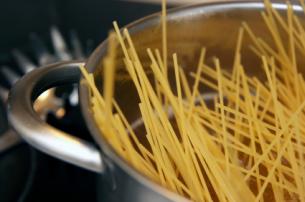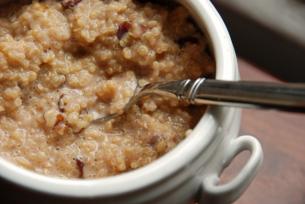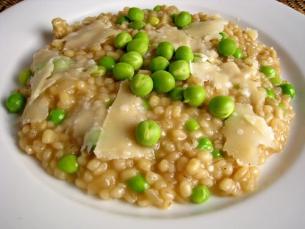Who can resist the lure of a bowl of salted mixed nuts?
Or the fun of cracking open peanuts in the shell?
The buttery crunch of nuts can take dishes from ordinary to extraordinary. Cooked green beans, for example, become much more appetizing when sprinkled with a handful of toasted, slivered almonds.
Although they can be addictive, nuts have a number of health benefits (see calorie, fat and protein chart at the bottom of this post), and have been shown to help keep cholesterol in check. There’s no problem with eating them regularly, if you limit your intake to one to two ounces per day and stick to the unsalted kind. As an alternative to eating them straight-up as a snack, nuts add flavor and texture to all kinds of other foods: salad, yogurt, cereal, stir-fries, rice or pasta. It’s a good idea to keep walnuts or pecans on hand for baking; they’re great in chocolate chip cookies and brownies.
From Brazil nuts to pistachios, there are a lot of nuts to choose from. This post will help identify when to use what kind of nuts, as well as how to store, toast and chop them.
How to Store Nuts
Although they may look like a non-perishable food item, nuts can go rancid quickly because of their fat content. Shelled nuts go off faster than those still in their shells, and the packages do have best before dates stamped on them. It’s a good idea to store nuts in the fridge or the freezer. Sources vary on how long nuts keep, but one rule of thumb is:
- A month at room temperature
- Up to six months in the fridge
- Up to one year in the freezer
Nuts should be kept in a non-metal, airtight container. Even a resealable freezer bag will do the trick.
How to Toast Nuts
Just like bread, nuts taste better toasted. The heat brings out their sweetness and makes them crunchier. Startcooking.com covers how to toast nuts in the post on pine nuts. If you like sprinkling toasted nuts on various dishes, it’s a good idea to roast a few cups so that you have them on hand to use later.
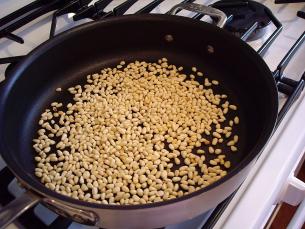
When toasting nuts, don’t take your eyes off the pan! They burn quickly.
How to Chop Nuts
Although it’s possible to buy nuts already chopped, there are several ways to chop them yourself.
- One way to do it is to get out a chopping board, a sharp serrated edge knife and start chopping. Hold the handle of the knife in one hand, and the hold the tip of the knife to the chopping board with the other hand. As you chop, move the handle-end of the knife back and forth over the nuts so that you get them all. Keep gathering the nuts back into a mound and going over them with the knife until they’re the right size.
- An easier way to chop nuts is not to chop them at all! Put the nuts in a resealable bag and roll over the bag with a rolling pin, or crush the nuts with a kitchen mallet or hammer. This is a fast, mess-free way to get the job done! Plus, it’s a fast way to chop large quantities.
- Another way to chop or grind nuts is to put them in the blender or food processor in small batches. Pulse (turn the machine on and off quickly) several times until the nuts are the desired size. This is a fast way to get the job done, but may result in uneven chopping.
Now, let’s go meet all those nuts!
Almonds
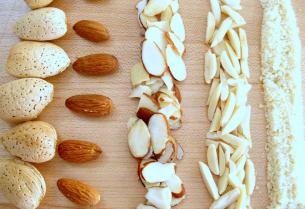
This shot shows (from left) almonds in the shell, whole, sliced, slivered and ground.
Almonds are packed with all kinds of nutrients, including protein, calcium, fiber, riboflavin and magnesium. Almonds are among the drier, crunchier nuts. Enjoy them whole as a healthy snack, or try them blanched or slivered and sprinkled on salads or cooked vegetables. Cooking For Engineers offers a nice photo-tutorial on Asparagus with Almonds. Ground almonds or almond paste (marzipan) may be called for in dessert recipes.
Here are some of the different forms of almonds and what they’re best suited for:
- Whole natural: Great for snacking
- Dry roasted: These are also meant for snacking, but their rich flavor works well in some recipes, like in this Green Pea and Smoked Almond Salad.
- Blanched: These almonds are typically whole, but have the skins removed. They’re often used as garnish.
- Slivered: These almonds have been sliced into thin slivers, but still have lots of crunch. They’re great to use as toppings on dishes like salads, pasta or cooked vegetables.
- Sliced: These are also used as toppings in savory dishes, but are also often used to top cakes, muffins and pastries. They’re sliced thinly, so they don’t offer much crunch.
- Ground: Ground almonds can be added to a breading mixture that goes on meat or fish, or added to a smoothie. You can make your own ground almonds by putting almonds in the blender or food processor.
Peanuts
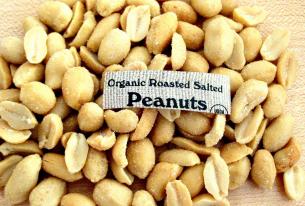
You can buy peanuts in the shell, unshelled, whole, salted, unsalted, roasted, chopped or chocolate covered! We probably consume peanuts most often in the form of peanut butter. Peanuts can be used in a wide range of sweet and savory recipes, including recipes like Chicken in Lettuce Cups. Like almonds, they make a great topping for all kinds of dishes; chopped peanuts are often used as a topping in Thai dishes and Asian stir fries.
Walnuts
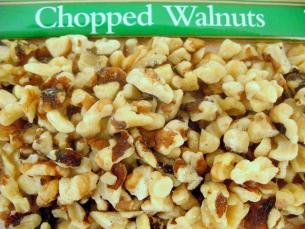
These nuts are higher than any others in terms of their Omega-3 fatty acid content and have been shown to lower bad cholesterol. Chopped walnuts are often called for in cookie, bar and loaf recipes, and are often paired with maple flavor in desserts (such as maple walnut ice cream!). Walnuts can also be used in coatings for fish or meat. As turkey time approaches, keep in mind this recipe for Cranberry Relish with Walnuts and Mandarin Oranges. Walnut oil is an expensive, but elegant, base for a salad dressing.
Pecans
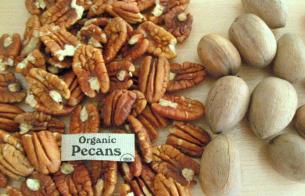
Their taste is similar to walnuts, but sweeter and richer because of their high fat content. Pecans are great eaten on their own, or when used in salads, like this Pear and Blue Cheese Salad. They can substitute for walnuts in baking recipes and are, of course, the central ingredient in Pecan Pie.
Brazil nuts
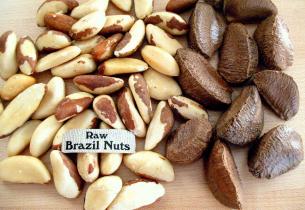
These large, crescent-shaped nuts are mainly exported from Bolivia, rather than Brazil. The seeds of the Brazil nut tree are very high in the antioxidant selenium. They’re not called for in everyday recipes, but often show up in nut mixes or fruit cake.
Pistachios
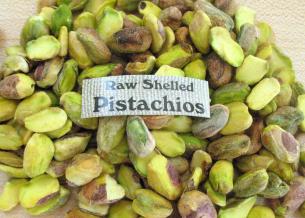
Somehow, it’s so satisfying to pop a pistachio out of its shell and eat it. And then another. And another. These nuts have really been around the block: they originated in the Middle East, were mentioned in the Bible, and even have an ice cream flavor dedicated to them. Home cooks can use shelled pistachios to top rice or other dishes the same way they would with other nuts. They can also be used instead of pine nuts as the base of pesto and in sweets, like these Pistachio and White Chocolate Chip Cookies. Those that are sick and tired of being thwarted by pistachios whose shells are only open a crack will enjoy this tutorial that shows how to open them.
Cashews
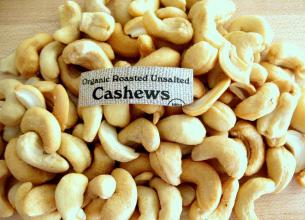
So buttery and soooooo addictive … we have all probably indulged in a handful (or two) of cashews over cocktails. Cashew lovers can also get their fix at Asian restaurants, where Chicken with Cashews may be on the menu. Try adding cashews to your own stir-fries.
Hazelnuts
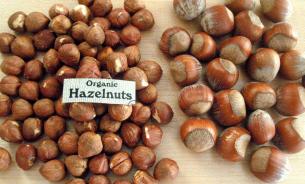
Hazelnuts (aka filberts) are more likely to be used in a dessert than a main dish, although they add an elegant touch to all kinds of foods. The combination of hazelnut and chocolate is widely enjoyed in the form of Nutella. The skins of hazelnuts taste bitter, and many recipes require that the skins be removed.
(The Hazelnut Council has some really great looking recipes with photos on their site.) For a really great treat, try Nutella Crepes (video) or Nutella Dessert Dip – they are amazing!
Pine Nuts
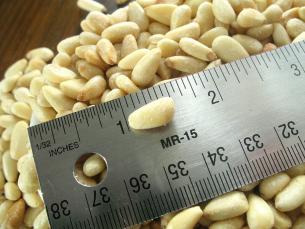
These nuts have a sweet, creamy crunch, and they’re great to keep on hand to sprinkle on salads or pasta. They’re also a key ingredient in pesto.
Startcooking.com has covered the basics of pine nuts, including a photo tutorial on how to toast them which is a toasting method that can be applied to toasting all nuts.
************
Nutrients in nuts per 1.5 ounces (43 grams)
|
Calories |
Fat (grams) |
Protein (grams) |
| Almonds |
254 |
22.5 |
9.4 |
| Brazil nuts |
279 |
28.2 |
6.1 |
| Cashews |
244 |
19.7 |
6.5 |
| Hazelnuts |
275 |
26.5 |
6.4 |
| Macadamias |
305 |
32.4 |
3.3 |
| Peanuts |
249 |
21.1 |
10.1 |
| Pecans |
302 |
31.6 |
4.0 |
| Pistachios |
243 |
19.6 |
9.1 |
| Walnuts |
278 |
27.7 |
6.5 |
Source: Harvard Medical School 2010
Report of the Dietary Guidelines Advisory Committee
